Partitioning and Migration of Trace Elements during Coal Combustion in Two Coal-Fired Power Plants in Hefei City, Anhui Province, Eastern China
Abstract
1. Introduction
2. Materials and Methods
2.1. Sampling Sites
2.2. Sampling
2.3. Experiments
3. Results
3.1. Elements in Feed Coal and Its Combustion by-Products—WN Power Plant
3.1.1. Trace Elements
3.1.2. REY
3.2. Elements in Feed Coal and Its By-Products—TY Power Plant
3.2.1. Trace Elements
3.2.2. REY
4. Discussion
4.1. Partitioning of Trace Elements in Coal Combustion By-Products
4.1.1. Effect of Ash Particle Size
4.1.2. Effect of Flue Gas Desulfurization
4.2. Effects of Ash Precipitation and Storage on Trace Elements in Fly Ash
4.3. Evaluation of Potential REY Resources in Coal Combustion By-Products
5. Conclusions
Supplementary Materials
Author Contributions
Funding
Data Availability Statement
Acknowledgments
Conflicts of Interest
References
- Xie, H.P.; Ren, S.H.; Xie, Y.C. Development opportunities of the coal industry towards the goal of carbon neutrality. J. China Coal Soc. 2021, 46, 2197–2211. (In Chinese) [Google Scholar]
- Xie, H.P.; Wu, L.X.; Zheng, D.Z. Prediction on the energy consumption and coal demand of China in 2025. J. China Coal Soc. 2019, 44, 1949–1960. (In Chinese) [Google Scholar]
- Chen, J.; Li, Y.; Jiang, P.; Li, X.; Qi, X.; Liu, W.; Chen, P. Comprehensive utilization of resources and potential environmental risk of the coal-hosted critical element deposits: A case from the Lincang Ge refinery. J. China Coal Soc. 2022, 47, 1885–1894. [Google Scholar]
- Font, O.; Córdoba, P.; Leiva, C.; Romeo, L.M.; Bolea, I.; Guedea, I.; Alvarez, E. Fate and abatement of mercury and other trace elements in a coal fluidised bed oxy combustion pilot plant. Fuel 2012, 95, 272–281. [Google Scholar] [CrossRef]
- Roy, B.; Bhattacharya, S. Oxy-fuel fluidized bed combustion using Victorian brown coal: An experimental investigation. Fuel Process. Technol. 2014, 117, 23–29. [Google Scholar] [CrossRef]
- Oboirien, B.O.; Thulari, V.; North, B.C. Enrichment of trace elements in bottom ash from coal oxy-combustion: Effect of coal types. Appl. Energy 2016, 177, 81–86. [Google Scholar] [CrossRef]
- Fuge, R. Fluorine in the environment, a review of its sources and geochemistry. Appl. Geochem. 2019, 100, 393–406. [Google Scholar] [CrossRef]
- Hu, Y.; Cheng, H. Control of mercury emissions from stationary coal combustion sources in China: Current status and recommendations. Environ. Pollut. 2016, 218, 1209–1221. [Google Scholar] [CrossRef]
- Zhang, Y.; Ye, X.; Yang, T.; Li, J.; Chen, L.; Zhang, W.; Wang, X. Evaluation of costs associated with atmospheric mercury emission reductions from coal combustion in China in 2010 and projections for 2020. Sci. Total Environ. 2018, 610–611, 796–801. [Google Scholar] [CrossRef]
- Zhang, L.; Cao, N. Impact of fly ash field on groundwater environment in thermal power plants. Sci. Technol. Life 2011, 7, 209. (In Chinese) [Google Scholar]
- Swanson, S.M.; Engle, M.A.; Ruppert, L.F.; Affolter, R.H.; Jones, K.B. Partitioning of selected trace elements in coal combustion products from two coal-burning power plants in the United States. Int. J. Coal Geol. 2013, 113, 116–126. [Google Scholar] [CrossRef]
- Sun, Y.; Zhao, C.; Qin, S.; Xiao, L.; Li, Z.; Lin, M. Occurrence of some valuable elements in the unique ‘high-aluminum coals’ from the Jungar coalfield, China. Ore Geol. Rev. 2016, 72, 659–668. [Google Scholar] [CrossRef]
- Wang, J.; Yang, Z.; Qin, S.; Panchal, B.; Sun, Y.; Niu, H. Distribution characteristics and migration patterns of hazardous trace elements in coal combustion products of power plants. Fuel 2019, 258, 116062. [Google Scholar] [CrossRef]
- Bhangare, R.C.; Ajmal, P.Y.; Sahu, S.K.; Pandit, G.G.; Puranik, V.D. Distribution of trace elements in coal and combustion residues from five thermal power plants in India. Int. J. Coal Geol. 2011, 86, 349–356. [Google Scholar] [CrossRef]
- Tang, Q.; Liu, G.; Zhou, C.; Sun, R. Distribution of trace elements in feed coal and combustion residues from two coal-fired power plants at Huainan, Anhui, China. Fuel 2013, 107, 315–322. [Google Scholar] [CrossRef]
- Dai, S.; Ren, D.; Tang, Y.; Yue, M.; Hao, L. Concentration and distribution of elements in Late Permian coals from western Guizhou Province, China. Int. J. Coal Geol. 2005, 61, 119–137. [Google Scholar] [CrossRef]
- Finkelman, R.B.; Orem, W.; Castranova, V.; Tatu, C.A.; Belkin, H.E.; Zheng, B.; Lerch, H.E. Health impacts of coal and coal use: Possible solutions. Int. J. Coal Geol. 2002, 50, 425–443. [Google Scholar] [CrossRef]
- Liu, G.; Vassilev, S.V.; Gao, L.; Zheng, L.; Peng, Z. Mineral and chemical composition and some trace element contents in coals and coal ashes from Huaibei coal field, China. Energy Convers. Manag. 2005, 46, 2001–2009. [Google Scholar] [CrossRef]
- USGS. Mineral Commodity Summaries, Rare Earths. 2017. Available online: https://minerals.usgs.gov/minerals/pubs/commodity/rare_earths/mcs-2017-raree.pdf (accessed on 4 October 2021).
- Dai, S.; Finkelman, R.B. Coal as a promising source of critical elements: Progress and future prospects. Int. J. Coal Geol. 2018, 186, 155–164. [Google Scholar] [CrossRef]
- Chen, J.; Zhang, B.; Zhang, S.; Zeng, J.; Chen, P.; Liu, W.; Wang, X. A complete atmospheric emission inventory of F, As, Se, Cd, Sb, Hg, Pb, and U from coal-fired power plants in Anhui Province, eastern China. Environ. Geochem. Health 2021, 43, 1817–1837. [Google Scholar] [CrossRef]
- D388-12; Standard Classification of Coals by Rank. ASTM International: West Conshohocken, PA, USA, 2012.
- Sun, R.; Liu, G.; Zheng, L.; Chou, C.L. Characteristics of coal quality and their relationship with coal-forming environment: A case study from the Zhuji exploration area, Huainan coalfield, Anhui, China. Energy 2010, 35, 423–435. [Google Scholar] [CrossRef]
- D2234M-16; Standard Test Method for Collection of a Gross Sample of Coal. ASTM International: West Conshohocken, PA, USA, 2016.
- Dai, S.; Wang, X.; Zhou, Y.; Hower, J.C.; Li, D.; Chen, W.; Zhu, X.; Zou, J. Chemical and mineralogical compositions of silicic, mafic, and alkali tonsteins in the late Permian coals from the Songzao Coalfield, Chongqing, Southwest China. Chem. Geol. 2011, 282, 29–44. [Google Scholar] [CrossRef]
- Li, X.; Dai, S.; Zhang, W.; Li, T.; Zheng, X.; Chen, W. Determination of As and Se in coal and coal combustion products using closed vessel microwave digestion and collision/reaction cell technology (CCT) of inductively coupled plasma mass spectrometry (ICP-MS). Int. J. Coal Geol. 2014, 124, 1–4. [Google Scholar] [CrossRef]
- Dai, S.; Graham, I.T.; Ward, C.R. A review of anomalous rare earth elements and yttrium in coal. Int. J. Coal Geol. 2016, 159, 82–95. [Google Scholar] [CrossRef]
- Zhang, B.; Chen, J.; Sha, J.; Zhang, S.; Zeng, J.; Chen, P.; Yao, D.; Liu, W.; Wang, X.; Zhang, P.; et al. Geochemistry of coal thermally-altered by igneous intrusion: A case study from the Pansan Coal Mine of Huainan Coalfield, Anhui, Eastern China. J. Geochem. Explor. 2020, 213, 106532. [Google Scholar] [CrossRef]
- Dai, S.; Ren, D.; Chou, C.-L.; Finkelman, R.B.; Seredin, V.V.; Zhou, Y. Geochemistry of trace elements in Chinese coals: A review of abundances, genetic types, impacts on human health, and industrial utilization. Int. J. Coal Geol. 2012, 94, 3–21. [Google Scholar] [CrossRef]
- Dai, S.; Zhao, L.; Peng, S.; Chou, C.L.; Wang, X.; Zhang, Y.; Li, D.; Sun, Y. Abundances and distribution of minerals and elements in high-alumina coal fly ash from the Jungar Power Plant, Inner Mongolia, China. Int. J. Coal Geol. 2010, 81, 320–332. [Google Scholar] [CrossRef]
- Meij, R. Trace element behavior in coal-fired power plants. Fuel Process. Technol. 1994, 39, 199–217. [Google Scholar] [CrossRef]
- Ouyang, Z. Enrichment of heavy metals in fine particles during coal combustion. Fuel Energy Abstr. 1997, 38, 379. [Google Scholar]
- Córdoba, P. Partitioning and speciation of selenium in wet limestone flue gas desulphurisation systems: A review. Fuel 2017, 202, 184–195. [Google Scholar] [CrossRef]
- Rudnick, R.L.; Gao, S. Composition of the Continental Crust. In Treatise on Geochemistry; Holland, H.D., Turekian, K.K., Eds.; Elsevier: Oxford, UK, 2014; pp. 1–51. [Google Scholar]
- Seredin, V.V.; Dai, S. Coal deposits as potential alternative sources for lanthanides and yttrium. Int. J. Coal Geol. 2012, 94, 67–93. [Google Scholar] [CrossRef]
- Chen, J.; Liu, G.; Li, H.; Wu, B. Mineralogical and geochemical responses of coal to igneous intrusion in the Pansan Coal Mine of the Huainan coalfield, Anhui, China. Int. J. Coal Geol. 2014, 124, 11–35. [Google Scholar] [CrossRef]
- Dai, S.; Zhang, W.; Ward, C.R.; Seredin, V.V.; Hower, J.C.; Li, X.; Song, W.; Wang, X.; Kang, H.; Zheng, L. Mineralogical and geochemical anomalies of late Permian coals from the Fusui Coalfield, Guangxi Province, southern China: Influences of terrigenous materials and hydrothermal fluids. Int. J. Coal Geol. 2013, 105, 60–84. [Google Scholar] [CrossRef]
- Dai, S.; Wang, P.; Ward, C.R.; Tang, Y.; Song, X.; Jiang, J.; Hower, J.C.; Li, T.; Serdin, V.V.; Wangner, N.J.; et al. Elemental and mineralogical anomalies in the coal-hosted Ge ore deposit of Lincang, Yunnan, southwestern China: Key role of N2–CO2-mixed hydrothermal solutions. Int. J. Coal Geol. 2015, 152, 19–46. [Google Scholar] [CrossRef]
- Hood, M.M.; Taggart, R.K.; Smith, R.C.; Hsu-Kim, H.; Hower, J.C. Rare earth element distribution in fly ash derived from the Fire Clay coal, Kentucky. Coal Combust. Gasif. Prod. 2017, 9, 22–33. [Google Scholar] [CrossRef]
- Furimsky, E. Characterization of trace element emissions from coal combustion by equilibrium calculations. Fuel Process. Technol. 2000, 63, 29–44. [Google Scholar] [CrossRef]
- Seames, W.S.; Wendt, J. Regimes of association of arsenic and selenium during pulverized coal combustion. Proc. Combust. Inst. 2007, 31, 2839–2846. [Google Scholar] [CrossRef]
- Wen, M.Z.; Xu, W.D. Mobility and release of hazardous trace elements in coal-fired power plant. J. China Coal Soc. 2010, 35, 1518–1523. (In Chinese) [Google Scholar]
- Shah, P.; Strezov, V.; Nelson, P.F. Speciation of chromium in Australian coals and combustion products. Fuel 2012, 102, 1–8. [Google Scholar] [CrossRef]
- Yi, H.; Hao, J.; Lei, D.; Tang, X.; Ning, P.; Li, X. Fine particle and trace element emissions from an anthracite coal-fired power plant equipped with a bag-house in China. Fuel 2008, 87, 2050–2057. [Google Scholar] [CrossRef]
- Helble, J.J. A model for the air emissions of trace metallic elements from coal combustors equipped with electrostatic precipitators. Fuel Process. Technol. 2000, 63, 125–147. [Google Scholar] [CrossRef]
- Al-Abed, S.R.; Jegadeesan, G.; Scheckel, K.G.; Tolaymat, T. Speciation, characterization, and mobility of As, Se, and Hg in flue gas desulphurization residues. Environ. Sci. Technol. 2008, 42, 1693–1698. [Google Scholar] [CrossRef]
- Font, O.; Izquierdo, M.; Ochoa-Gonzalez, R.; Leiva, C.; Alvarez, E. Fate of trace pollutants in PCC-FGD power plants. In Proceedings of the World of Coal Ash—WOCA Conference, Lexington, KY, USA, 4–7 May 2009. [Google Scholar]
- Tang, Q.; Liu, G.; Yan, Z.; Sun, R. Distribution and fate of environmentally sensitive elements (arsenic, mercury, stibium and selenium) in coal-fired power plants at Huainan, Anhui, China. Fuel 2012, 95, 334–339. [Google Scholar] [CrossRef]
- Xu, M.; Yan, R.; Zheng, C.; Qiao, Y.; Han, J.; Sheng, C. Status of trace element emission in a coal combustion process: A review. Fuel Process. Technol. 2004, 85, 215–237. [Google Scholar] [CrossRef]
- Zhang, J.Y.; Ren, D.Y.; Zhong, Q.; Xu, F.M.; Zhang, Y.G.; Yin, J.S. Retention of selenium volatility using lime in coal combustion. Environ. Sci. Technol. 2003, 22, 100–103. (In Chinese) [Google Scholar]
- Li, J.; Liu, T.L. The effect on leaching behavior of heavy metals contained in fly ash by using CaO. J. Northeast. China Inst. Electr. Power Eng. Nat. Sci. Ed. 2005, 2, 85–87. [Google Scholar]
- Ward, C.R.; French, D.; Jankowski, J.; Dubikova, M.; Li, Z.; Riley, K.W. Element mobility from fresh and long-stored acidic fly ashes associated with an Australian power station. Int. J. Coal Geol. 2009, 80, 224–236. [Google Scholar] [CrossRef]
- Oliveira, M.L.S.; Ward, C.R.; French, D.; Hower, J.C.; Querol, X.; Silva, L.F.O. Mineralogy and leaching characteristics of beneficiated coal products from Santa Catarina, Brazil. Int. J. Coal Geol. 2012, 94, 314–325. [Google Scholar] [CrossRef]
- Jankowski, J.; Dubikova, M.; Ward, C.R.; French, D. An application of hydrogeochemical modelling in understanding chemical reactions in fly ash-water interaction during batch leaching tests of acidic fly ashes. In Proceedings of the 22nd International Pittsburgh Coal Conference, Pittsburgh, PA, USA, 12–15 September 2005. [Google Scholar]
- Ketris, M.P.; Yudovich, Y. Estimations of Clarkes for Carbonaceous biolithe: World averages for trace element contents in black shales and coals. Int. J. Coal Geol. 2009, 78, 135–148. [Google Scholar] [CrossRef]
- Dai, S.; Xie, P.; Jia, S.; Ward, C.R.; Hower, J.C.; Yan, X.; French, D. Enrichment of U-Re-V-Cr-Se and rare earth elements in the Late Permian coals of the Moxinpo Coalfield, Chongqing, China: Genetic implications from geochemical and mineralogical data. Ore Geol. Rev. 2017, 80, 1–17. [Google Scholar] [CrossRef]

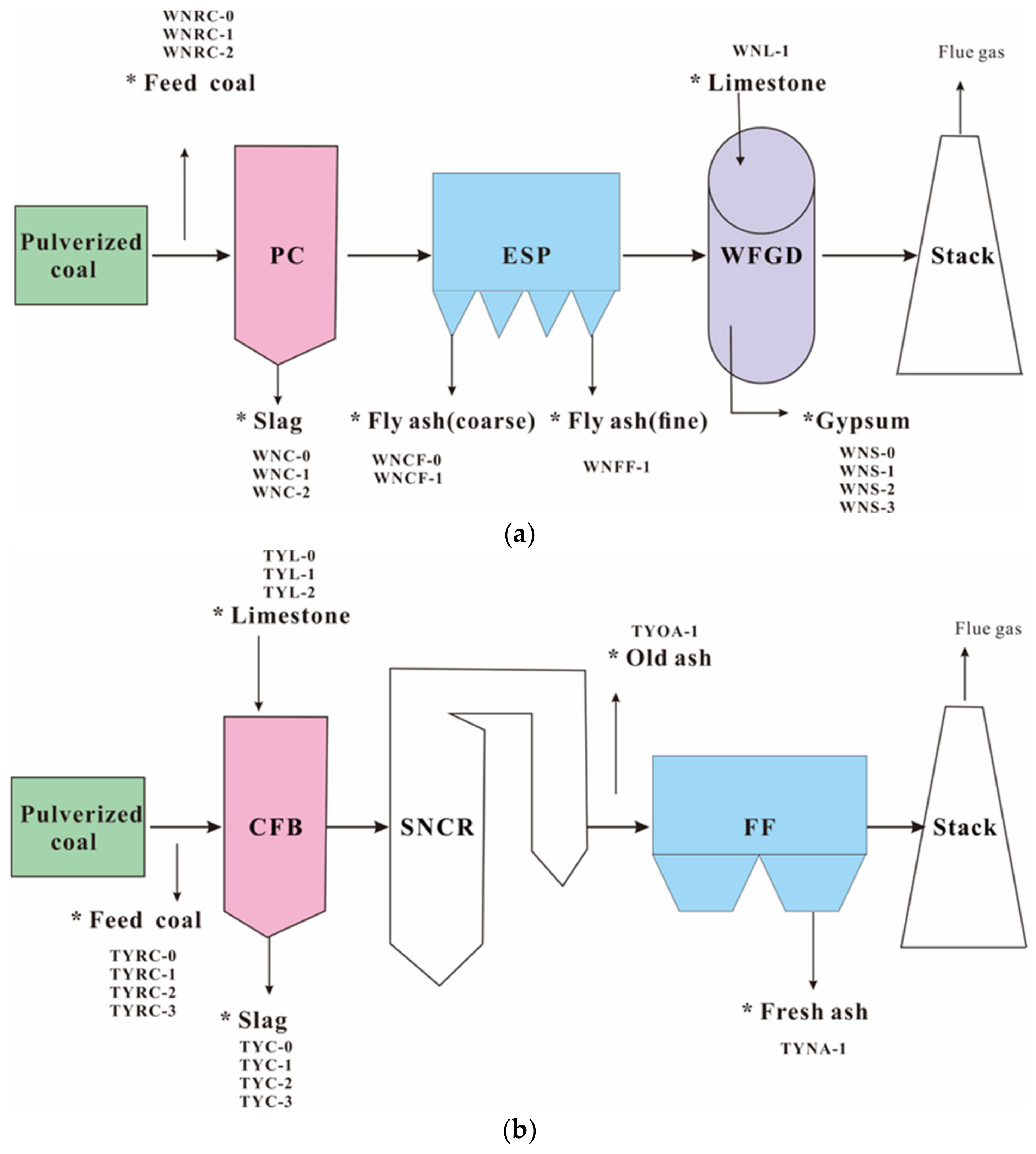
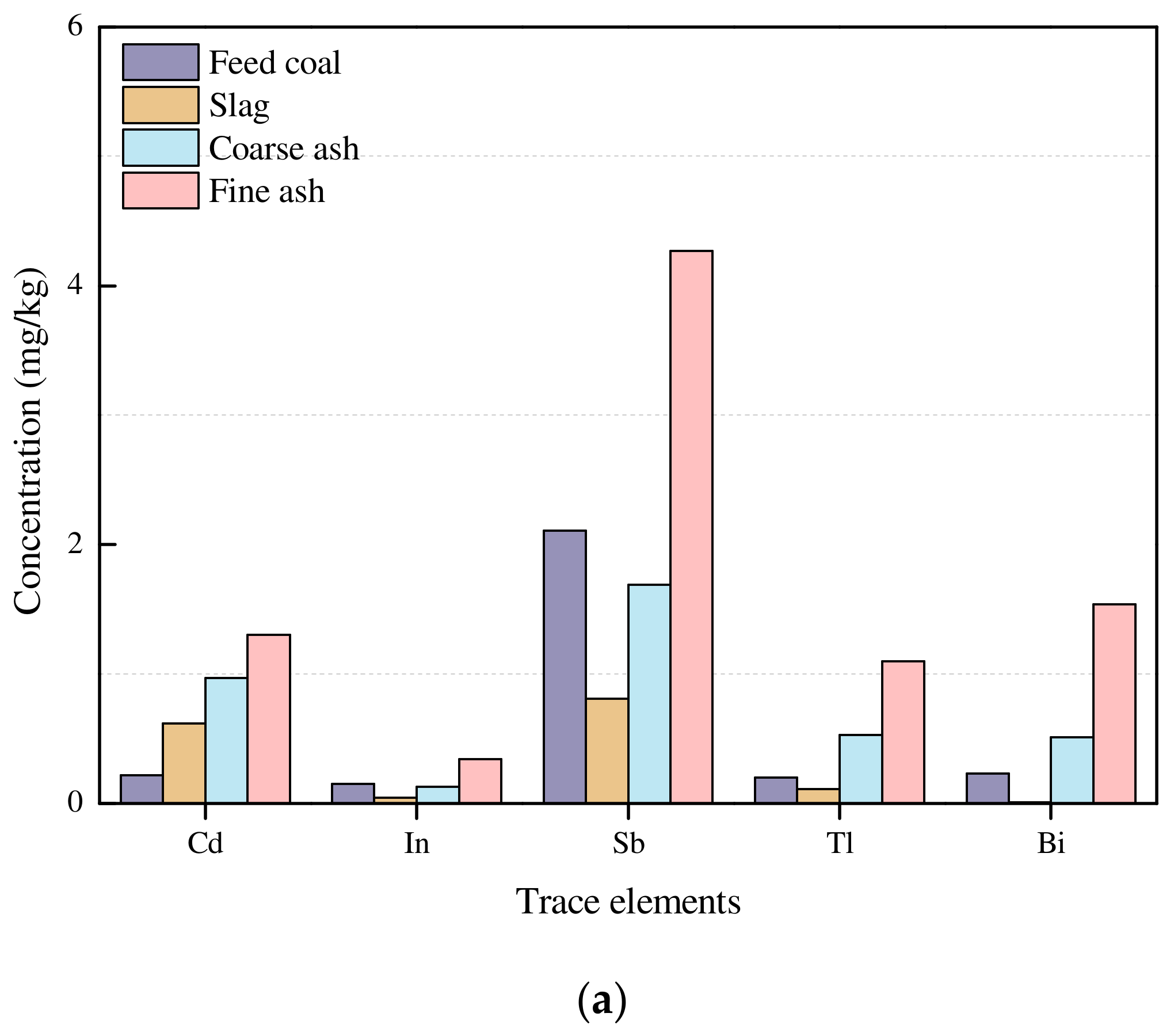
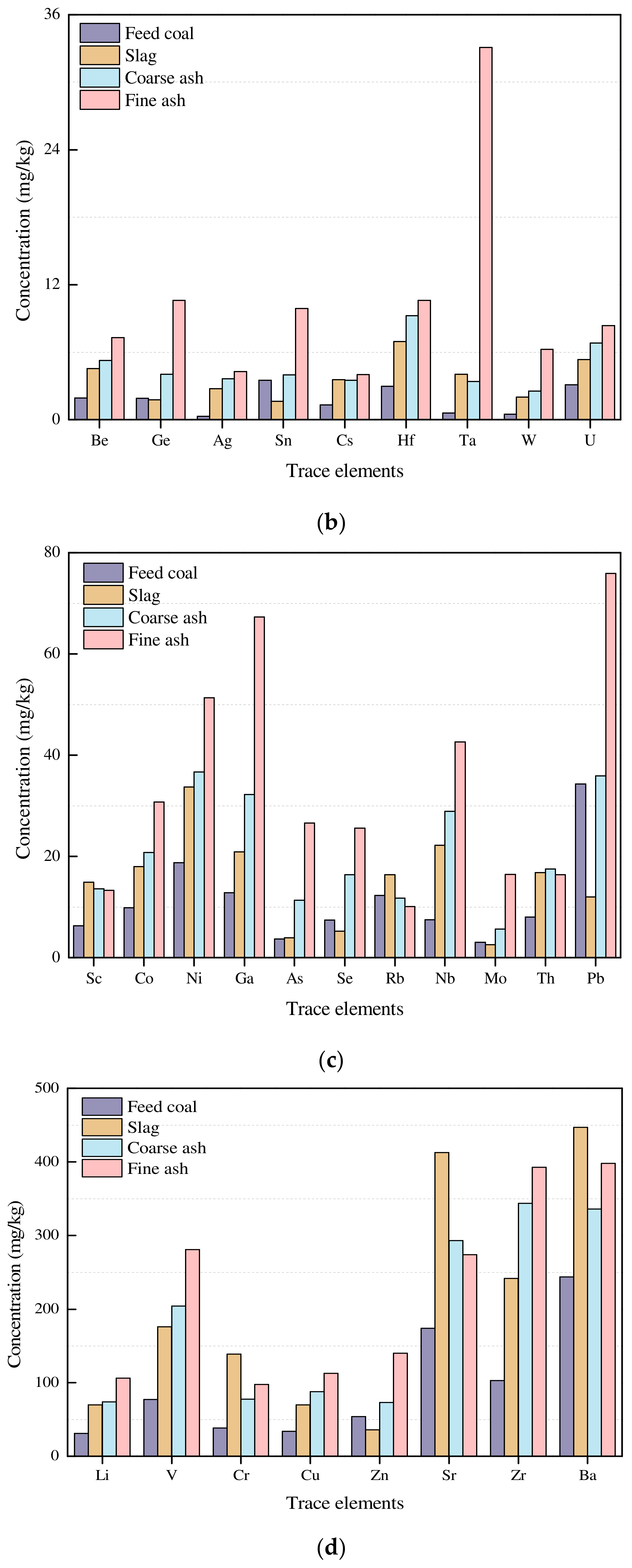
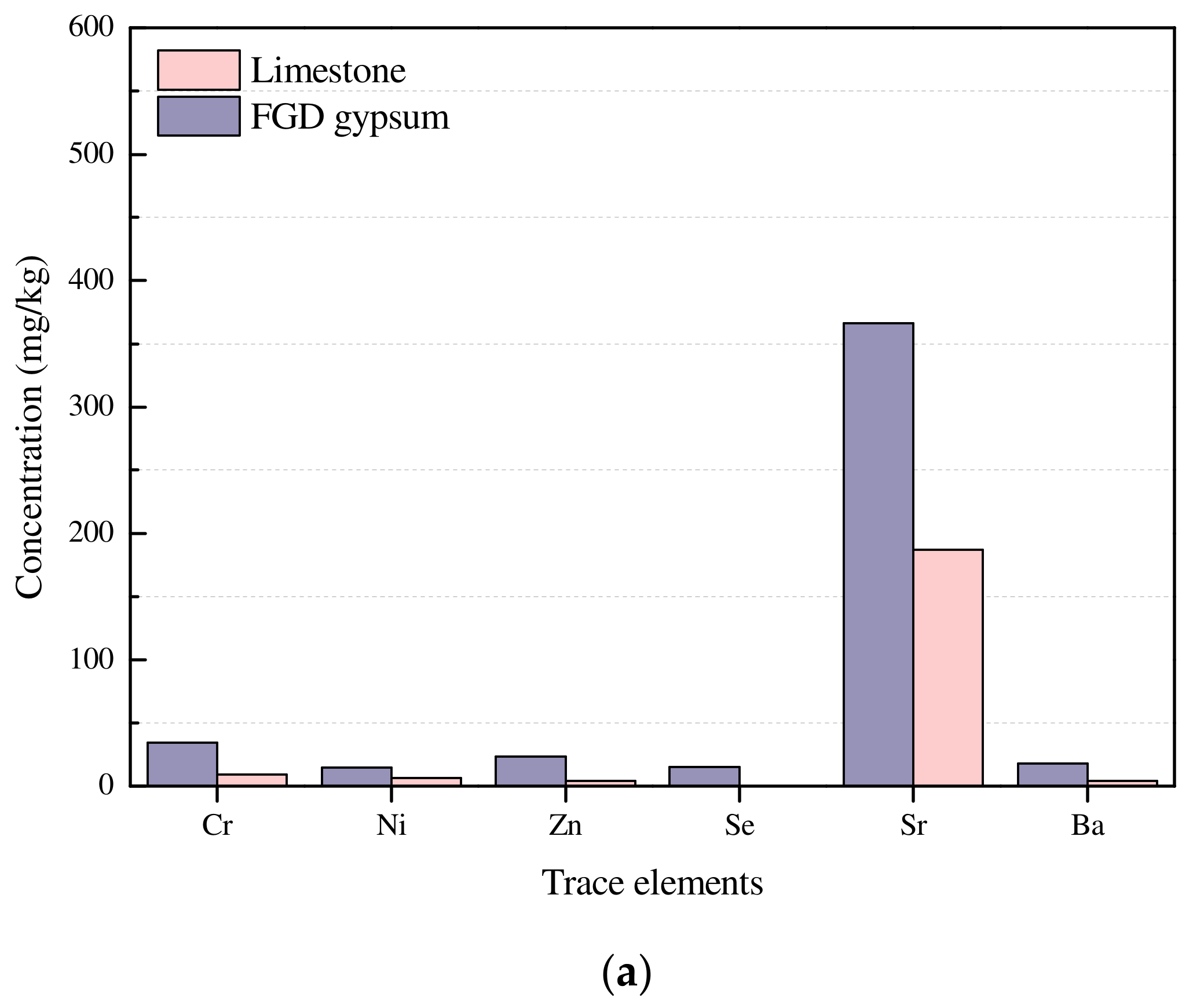
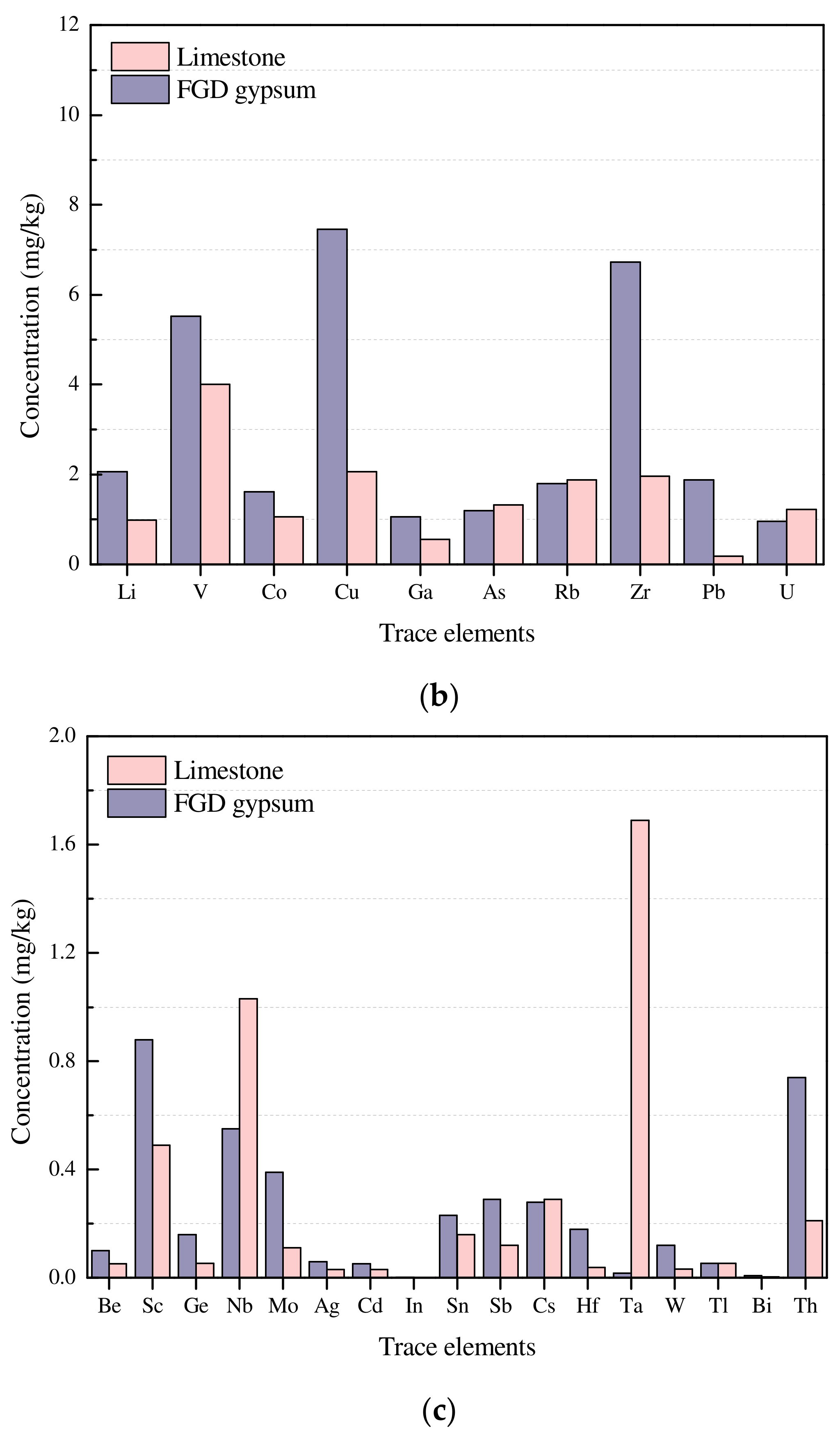
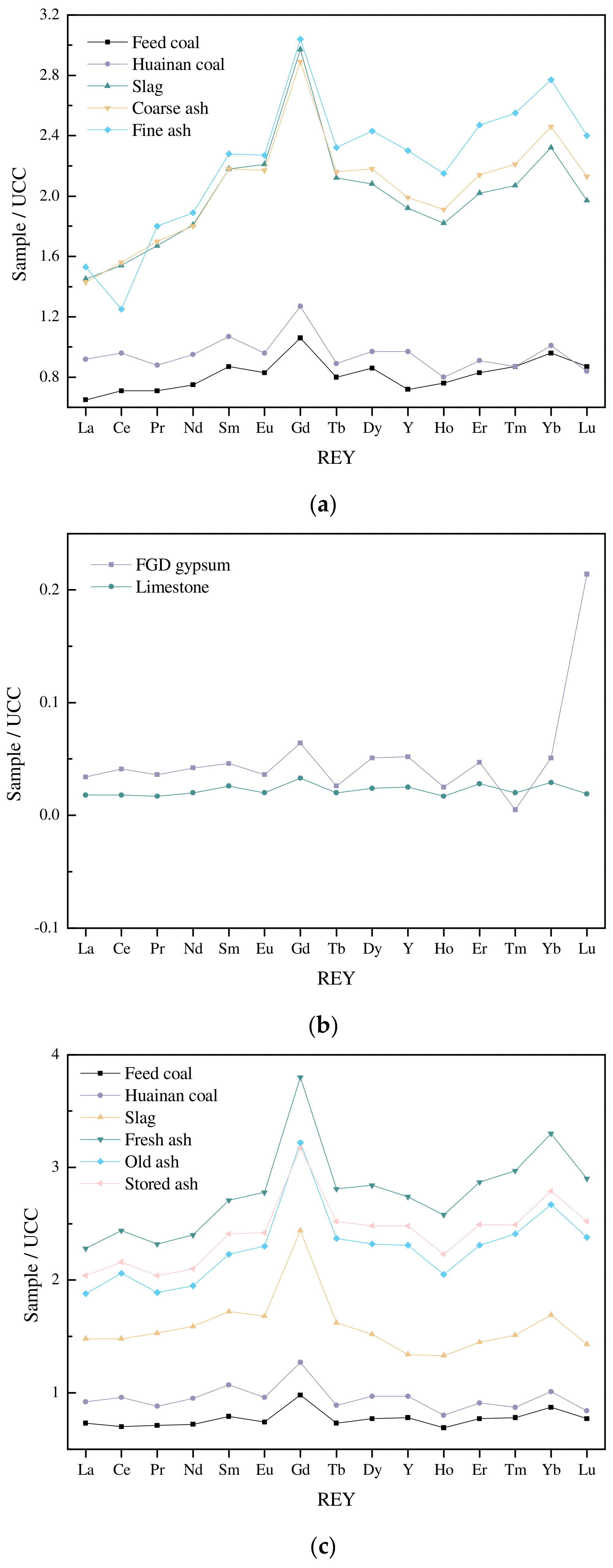

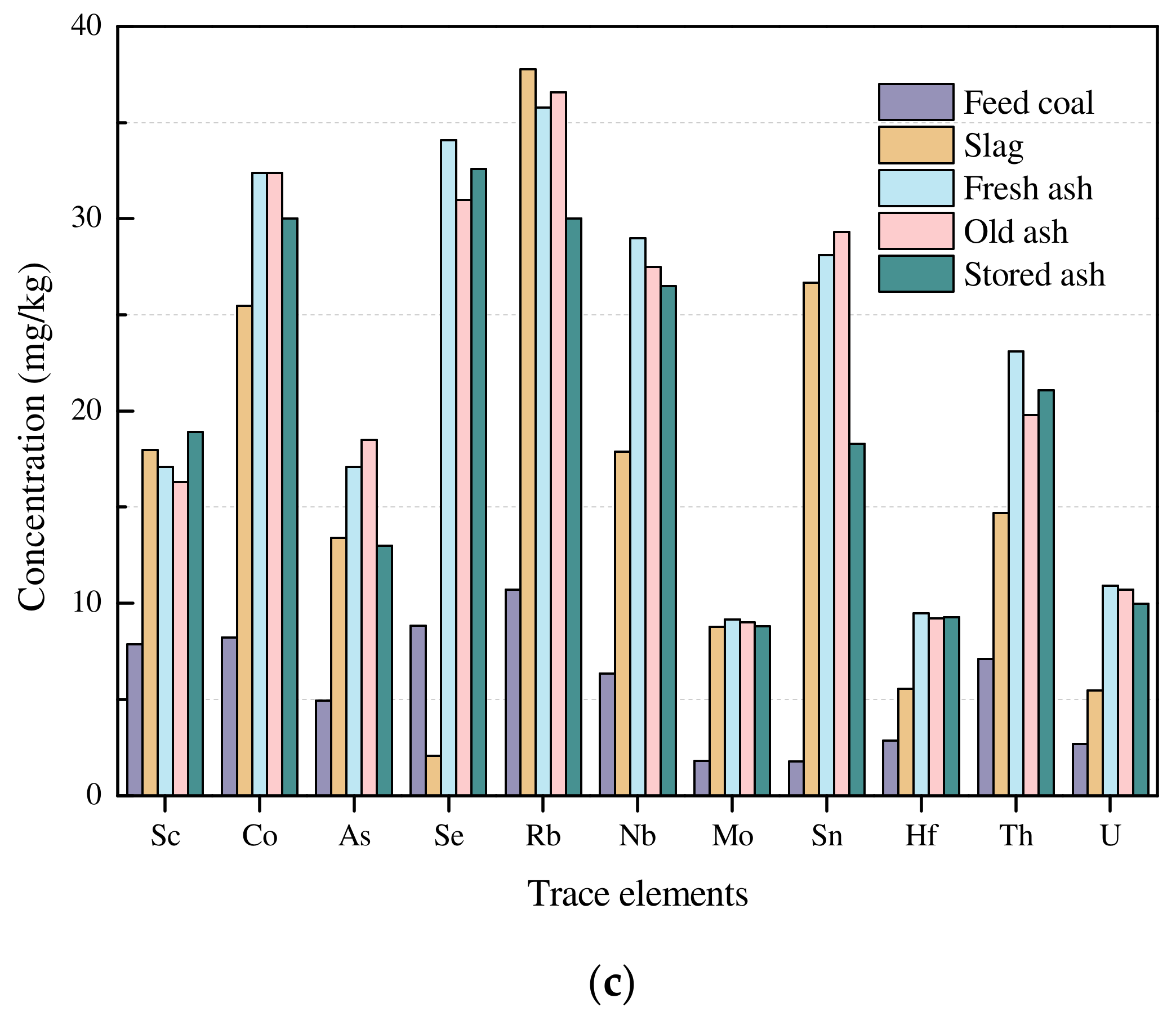
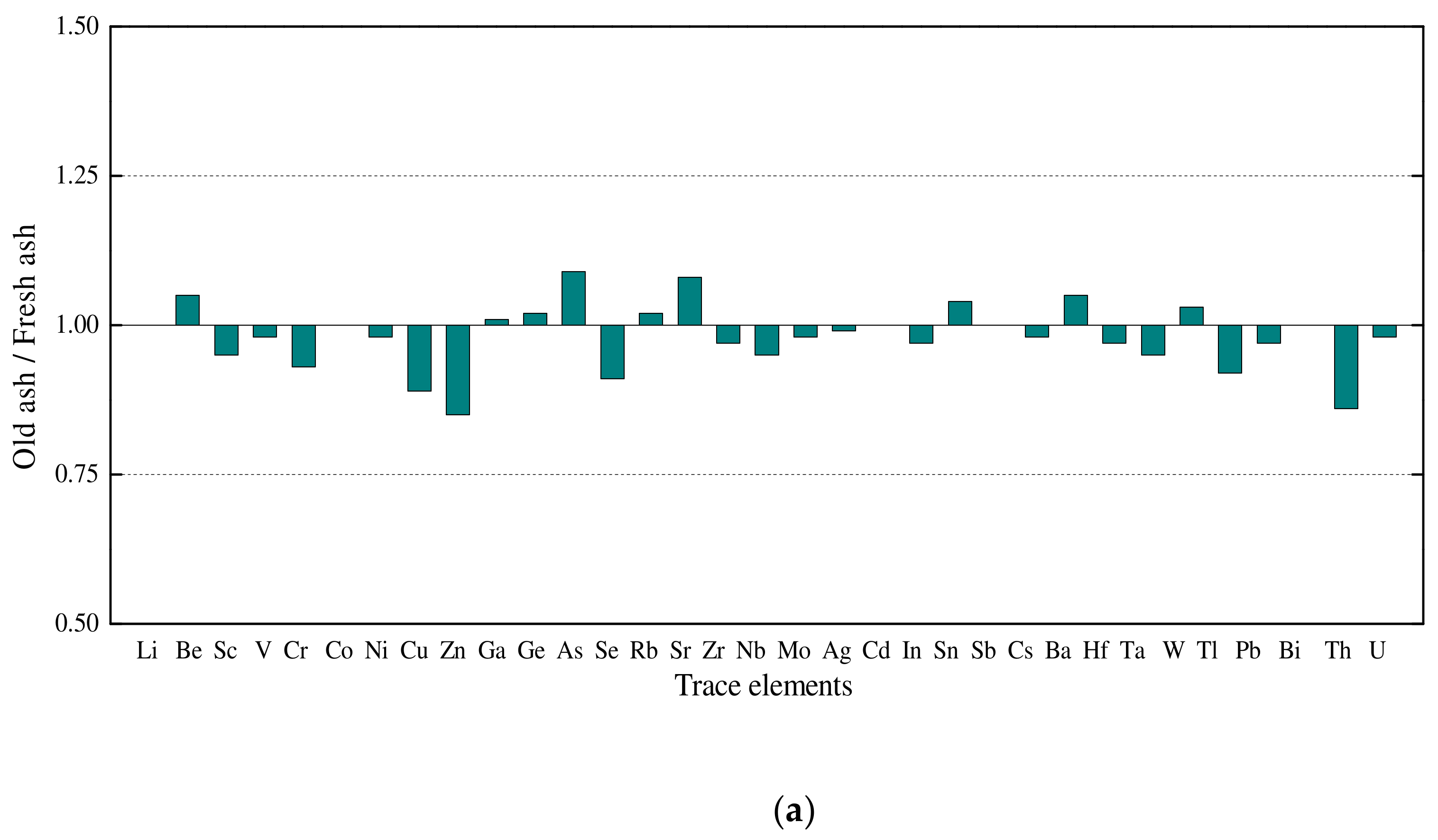
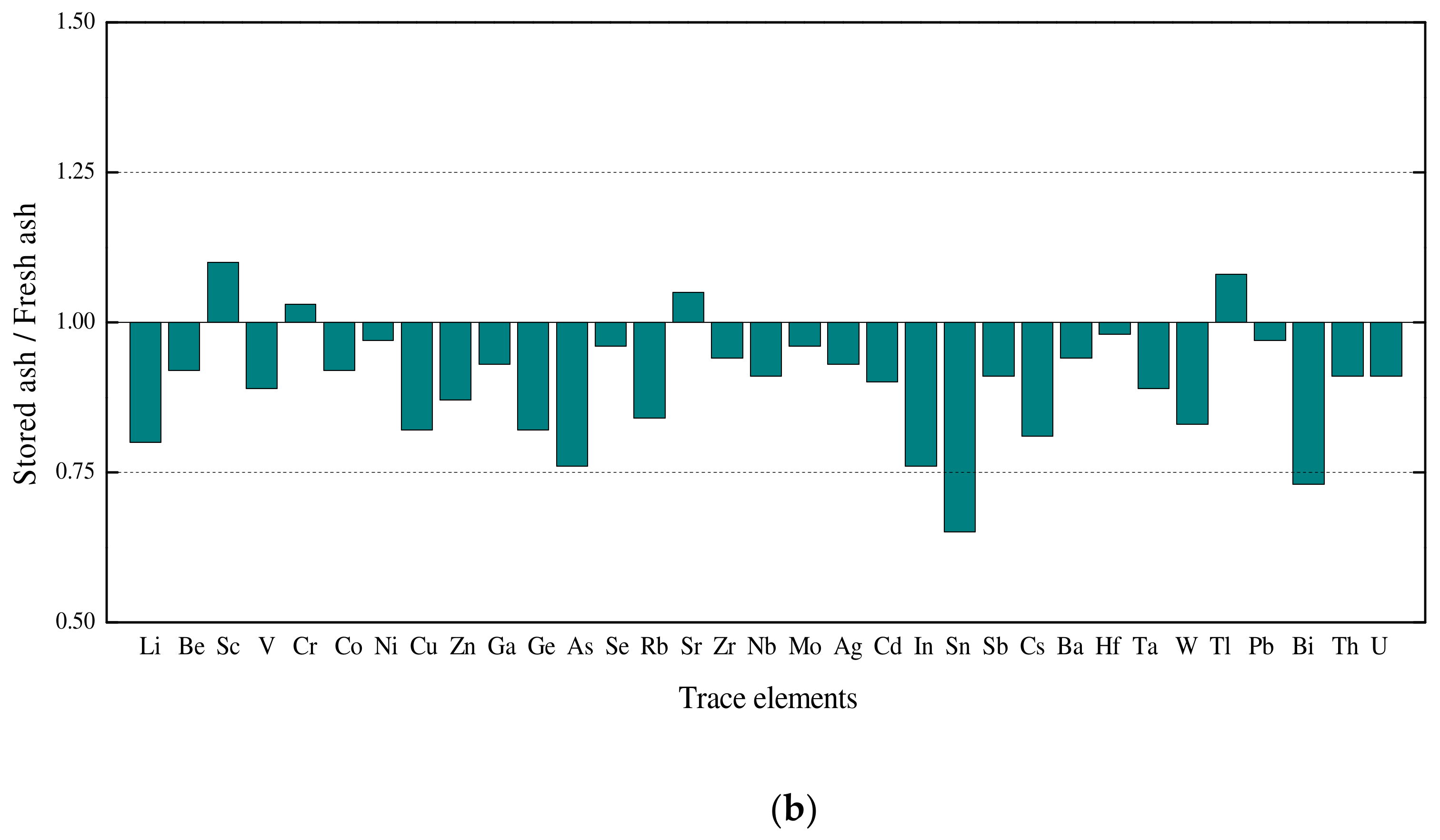
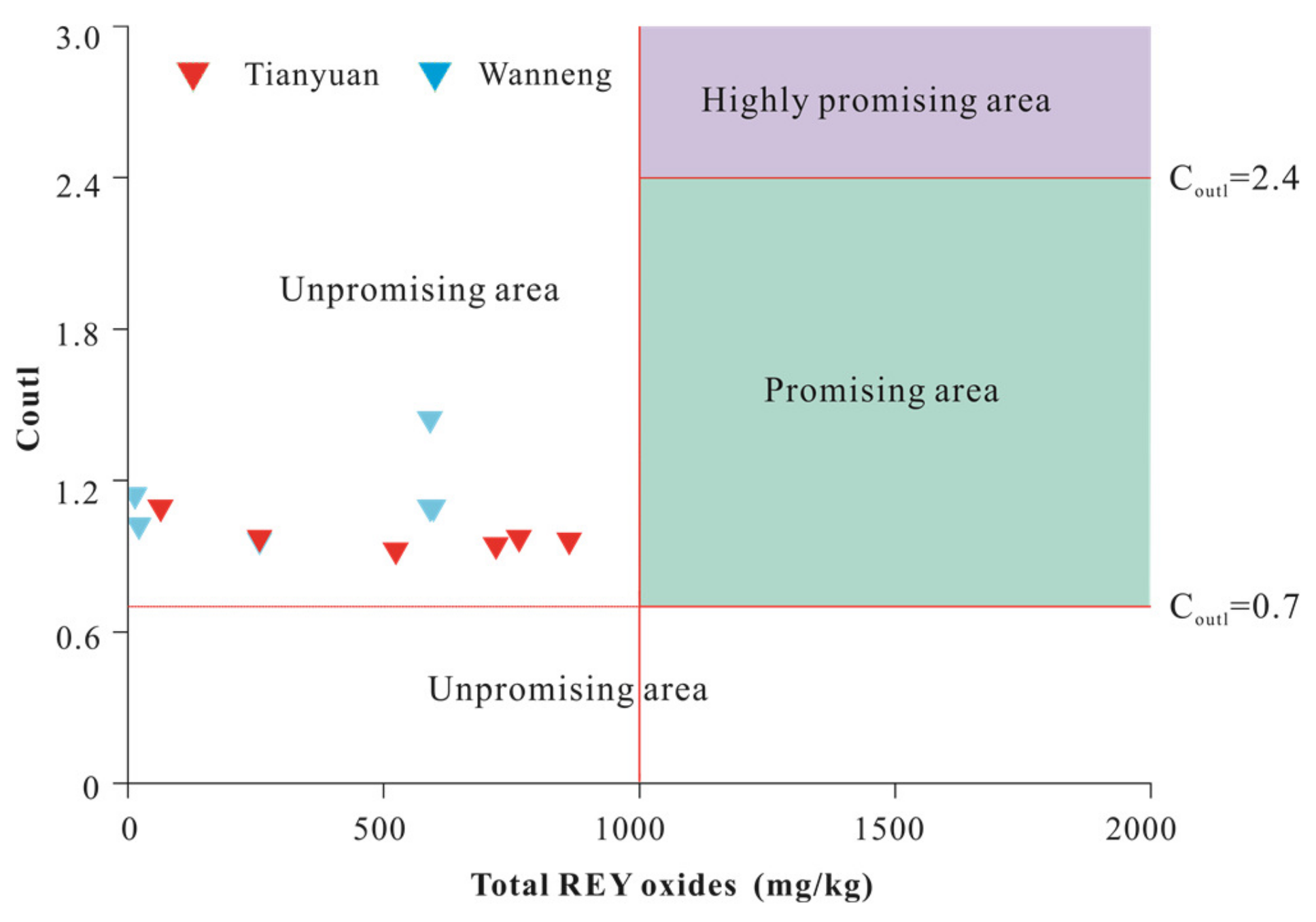
| Plants | Sample Description | Number | Sample No. |
|---|---|---|---|
| WN | Feed coal | 3 | WNRC-0, WNRC-1, WNRC-2 |
| Slag | 3 | WNC-0, WNC-1, WNC-2 | |
| Coarse ash | 2 | WNCF-0, WNCF-1 | |
| Fine ash | 1 | WNFF-1 | |
| Limestone | 1 | WNL-1 | |
| FGD gypsum | 4 | WNS-0, WNS-1, WNS-2, WNS-3 | |
| TY | Feed coal | 4 | TYRC-0, TYRC-1, TYRC-2, TYRC-3 |
| Slag | 4 | TYC-0, TYC-1, TYC-2, TYC-3 | |
| Fresh ash | 1 | TYNA-1 | |
| Old ash a | 1 | TYOA-1 | |
| Stored ash b | 1 | TYSA-1 | |
| Limestone | 3 | TYL-0, TYL-1, TYL-2 |
| Elements | Feed Coal | Huainan Coal a | Chinese Coal b | Slag | Coarse Ash | Fine Ash | Limestone | FGD Gypsum |
|---|---|---|---|---|---|---|---|---|
| Li | 31.2 | 34.5 | 31.8 | 69.9 | 74.1 | 106 | 0.98 | 2.06 |
| Be | 1.92 | 2.37 | 2.11 | 4.56 | 5.26 | 7.28 | 0.052 | 0.10 |
| Sc | 6.30 | 7.96 | 4.38 | 14.9 | 13.6 | 13.3 | 0.49 | 0.88 |
| V | 77.2 | 70.1 | 35.1 | 176 | 204 | 281 | 4.00 | 5.52 |
| Cr | 38.4 | 35.4 | 15.4 | 139 | 77.5 | 97.7 | 9.29 | 34.1 |
| Co | 9.90 | 6.23 | 7.08 | 18.0 | 20.8 | 30.7 | 1.05 | 1.61 |
| Ni | 18.8 | 15.8 | 13.7 | 33.7 | 36.7 | 51.3 | 6.19 | 14.9 |
| Cu | 34.1 | 31.9 | 17.5 | 70.0 | 87.8 | 113 | 2.06 | 7.46 |
| Zn | 54.1 | 18.1 | 41.4 | 35.8 | 72.8 | 140 | 4.24 | 23.2 |
| Ga | 12.8 | 10.9 | 6.55 | 20.9 | 32.2 | 67.3 | 0.56 | 1.06 |
| Ge | 1.89 | 4.64 | 2.78 | 1.78 | 4.03 | 10.6 | 0.054 | 0.16 |
| As | 3.71 | 2.04 | 3.79 | 3.95 | 11.3 | 26.6 | 1.32 | 1.19 |
| Se | 7.41 | 4.99 | 2.47 | 5.26 | 16.4 | 25.6 | 0.018 | 15.0 |
| Rb | 12.3 | 9.58 | 9.25 | 16.4 | 11.8 | 10.1 | 1.88 | 1.80 |
| Sr | 174 | 157 | 140 | 413 | 293 | 274 | 187 | 366 |
| Zr | 103 | 98.2 | 89.5 | 242 | 344 | 393 | 1.96 | 6.72 |
| Nb | 7.45 | 4.75 | 9.44 | 22.2 | 28.9 | 42.6 | 1.03 | 0.55 |
| Mo | 3.05 | 1.38 | 3.08 | 2.55 | 5.64 | 16.49 | 0.11 | 0.39 |
| Ag | 0.32 | 0.44 | 0.50 | 2.76 | 3.64 | 4.28 | 0.030 | 0.060 |
| Cd | 0.22 | 0.26 | 0.25 | 0.62 | 0.97 | 1.30 | 0.030 | 0.052 |
| In | 0.15 | 0.03 | 0.047 | 0.046 | 0.13 | 0.34 | 0.001 | 0.002 |
| Sn | 3.50 | 1.17 | 2.11 | 1.65 | 3.99 | 9.88 | 0.16 | 0.23 |
| Sb | 2.11 | 0.83 | 0.84 | 0.81 | 1.69 | 4.27 | 0.12 | 0.29 |
| Cs | 1.31 | 0.81 | 1.13 | 3.54 | 3.50 | 4.01 | 0.29 | 0.28 |
| Ba | 244 | 144 | 159 | 447 | 336 | 398 | 4.23 | 17.8 |
| Hf | 2.97 | 2.15 | 3.71 | 6.96 | 9.25 | 10.6 | 0.039 | 0.18 |
| Ta | 0.59 | 0.26 | 0.62 | 4.03 | 3.40 | 33.1 | 1.69 | 0.017 |
| W | 0.49 | 2.89 | 1.08 | 2.01 | 2.54 | 6.25 | 0.032 | 0.12 |
| Tl | 0.20 | 0.28 | 0.47 | 0.11 | 0.53 | 1.10 | 0.053 | 0.053 |
| Pb | 34.3 | 15.3 | 15.1 | 12.0 | 35.9 | 75.9 | 0.18 | 1.88 |
| Bi | 0.23 | 0.12 | 0.79 | 0.012 | 0.51 | 1.54 | 0.004 | 0.008 |
| Th | 8.02 | 6.72 | 5.84 | 16.8 | 17.5 | 16.4 | 0.21 | 0.74 |
| U | 3.12 | 2.40 | 2.43 | 5.34 | 6.81 | 8.35 | 1.22 | 0.96 |
| Elements | La | Ce | Pr | Nd | Sm | Eu | Gd | Tb | Dy | Y | Ho | Er | Tm | Yb | Lu | REY |
|---|---|---|---|---|---|---|---|---|---|---|---|---|---|---|---|---|
| Feed coal | 20.3 | 44.9 | 5.06 | 20.3 | 4.07 | 0.83 | 4.23 | 0.56 | 3.34 | 15.2 | 0.63 | 1.91 | 0.26 | 1.89 | 0.27 | 124 |
| Huainan coal a | 28.6 | 60.3 | 6.26 | 25.6 | 5.02 | 0.96 | 5.09 | 0.62 | 3.79 | 20.3 | 0.66 | 2.09 | 0.26 | 1.97 | 0.26 | 162 |
| Slag | 45.0 | 97.0 | 11.9 | 48.8 | 10.2 | 2.21 | 11.9 | 1.48 | 8.10 | 40.4 | 1.51 | 4.65 | 0.62 | 4.54 | 0.61 | 289 |
| Coarse ash | 44.5 | 98.4 | 12.0 | 48.7 | 10.2 | 2.17 | 11.5 | 1.51 | 8.51 | 41.8 | 1.58 | 4.91 | 0.66 | 4.82 | 0.66 | 292 |
| Fine ash | 47.5 | 78.6 | 12.8 | 51.2 | 10.7 | 2.27 | 12.1 | 1.63 | 9.46 | 48.3 | 1.79 | 5.68 | 0.77 | 5.43 | 0.74 | 289 |
| Limestone | 0.56 | 1.11 | 0.12 | 0.55 | 0.12 | 0.020 | 0.13 | 0.014 | 0.095 | 0.53 | 0.014 | 0.06 | 0.006 | 0.056 | 0.006 | 3.38 |
| FGD gypsum | 1.07 | 2.58 | 0.25 | 1.13 | 0.22 | 0.036 | 0.26 | 0.018 | 0.20 | 1.10 | 0.021 | 0.11 | 0.001 | 0.10 | 0.066 | 7.15 |
| Chinese coal b | 22.5 | 46.7 | 6.42 | 22.3 | 4.07 | 0.84 | 4.65 | 0.62 | 3.74 | 18.2 | 0.96 | 1.79 | 0.64 | 2.08 | 0.38 | 136 |
| UCC c | 31.0 | 63.0 | 7.10 | 27.0 | 4.70 | 1.00 | 4.00 | 0.70 | 3.90 | 21.0 | 0.83 | 2.30 | 0.30 | 1.96 | 0.31 | 169 |
| Elements | Feed Coal | Huainan Coal a | Chinese Coal b | Slag | Fresh Ash | Old Ash | Stored Ash | Limestone |
|---|---|---|---|---|---|---|---|---|
| Li | 28.0 | 34.5 | 31.8 | 61.3 | 88.4 | 88.3 | 70.8 | 5.57 |
| Be | 1.87 | 2.37 | 2.11 | 3.51 | 7.54 | 7.94 | 6.97 | 0.26 |
| Sc | 7.85 | 7.96 | 4.38 | 18.0 | 17.1 | 16.3 | 18.9 | 3.05 |
| V | 76.8 | 70.1 | 35.1 | 159 | 312 | 307 | 278 | 41.2 |
| Cr | 37.3 | 35.4 | 15.4 | 205 | 110 | 102 | 113 | 63.0 |
| Co | 8.20 | 6.23 | 7.08 | 25.5 | 32.4 | 32.4 | 30.0 | 3.95 |
| Ni | 17.0 | 15.8 | 13.7 | 64.2 | 59.7 | 58.7 | 58.1 | 27.0 |
| Cu | 29.3 | 31.9 | 17.5 | 63.9 | 159 | 141 | 130 | 5.98 |
| Zn | 25.0 | 18.1 | 41.4 | 118 | 208 | 178 | 180 | 29.3 |
| Ga | 13.2 | 10.9 | 6.55 | 34.8 | 42.2 | 42.8 | 39.1 | 2.42 |
| Ge | 1.80 | 4.64 | 2.78 | 5.55 | 5.83 | 5.96 | 4.77 | 0.16 |
| As | 4.93 | 2.04 | 3.79 | 13.4 | 17.1 | 18.5 | 13.0 | 7.52 |
| Se | 8.84 | 4.99 | 2.47 | 2.08 | 34.1 | 31.0 | 32.6 | 3.36 |
| Rb | 10.7 | 9.58 | 9.25 | 37.8 | 35.8 | 36.6 | 30.0 | 13.6 |
| Sr | 195 | 157 | 140 | 321 | 482 | 522 | 506 | 828 |
| Zr | 100 | 98.2 | 89.5 | 184 | 335 | 325 | 314 | 24.3 |
| Nb | 6.36 | 4.75 | 9.44 | 17.9 | 29.0 | 27.5 | 26.5 | 2.77 |
| Mo | 1.81 | 1.38 | 3.08 | 8.76 | 9.17 | 9.00 | 8.81 | 3.38 |
| Ag | 0.30 | 0.44 | 0.50 | 2.11 | 3.52 | 3.48 | 3.29 | 0.26 |
| Cd | 0.29 | 0.26 | 0.25 | 0.82 | 1.34 | 1.33 | 1.20 | 0.99 |
| In | 0.054 | 0.030 | 0.047 | 0.23 | 0.28 | 0.27 | 0.21 | 0.003 |
| Sn | 1.79 | 1.17 | 2.11 | 26.7 | 28.1 | 29.3 | 18.3 | 0.42 |
| Sb | 0.58 | 0.83 | 0.84 | 2.94 | 3.11 | 3.11 | 2.84 | 0.92 |
| Cs | 1.19 | 0.81 | 1.13 | 3.80 | 3.81 | 3.75 | 3.11 | 1.45 |
| Ba | 202 | 144 | 159 | 274 | 772 | 810 | 725 | 108 |
| Hf | 2.85 | 2.15 | 3.71 | 5.56 | 9.47 | 9.22 | 9.29 | 0.69 |
| Ta | 0.46 | 0.26 | 0.62 | 3.46 | 2.19 | 2.08 | 1.94 | 2.71 |
| W | 0.34 | 2.89 | 1.08 | 2.99 | 4.37 | 4.51 | 3.64 | 0.25 |
| Tl | 0.092 | 0.28 | 0.47 | 0.26 | 0.67 | 0.62 | 0.72 | 0.13 |
| Pb | 15.2 | 15.3 | 15.1 | 28.3 | 54.3 | 52.8 | 52.8 | 5.97 |
| Bi | 0.18 | 0.12 | 0.79 | 1.37 | 1.53 | 1.53 | 1.11 | 0.092 |
| Th | 7.10 | 6.72 | 5.84 | 14.7 | 23.1 | 19.8 | 21.1 | 3.28 |
| U | 2.69 | 2.40 | 2.43 | 5.48 | 10.9 | 10.7 | 9.98 | 3.51 |
| Elements | La | Ce | Pr | Nd | Sm | Eu | Gd | Tb | Dy | Y | Ho | Er | Tm | Yb | Lu | REY |
|---|---|---|---|---|---|---|---|---|---|---|---|---|---|---|---|---|
| Feed coal | 22.5 | 44.3 | 5.02 | 19.4 | 3.70 | 0.74 | 3.93 | 0.51 | 2.99 | 16.4 | 0.58 | 1.76 | 0.23 | 1.71 | 0.24 | 124 |
| Huainan coal a | 28.6 | 60.3 | 6.26 | 25.6 | 5.02 | 0.96 | 5.09 | 0.62 | 3.79 | 20.3 | 0.66 | 2.09 | 0.26 | 1.97 | 0.26 | 162 |
| Slag | 45.8 | 93.5 | 10.8 | 42.8 | 8.07 | 1.68 | 9.76 | 1.13 | 5.94 | 28.1 | 1.10 | 3.34 | 0.45 | 3.32 | 0.44 | 256 |
| Fresh ash | 70.7 | 154 | 16.5 | 64.7 | 12.7 | 2.78 | 15.2 | 1.96 | 11.1 | 57.6 | 2.14 | 6.61 | 0.89 | 6.48 | 0.90 | 424 |
| Old ash | 58.2 | 130 | 13.5 | 52.6 | 10.5 | 2.30 | 12.9 | 1.66 | 9.04 | 48.4 | 1.70 | 5.32 | 0.72 | 5.23 | 0.74 | 353 |
| Stored ash | 63.3 | 136 | 14.5 | 56.8 | 11.3 | 2.42 | 12.7 | 1.77 | 9.67 | 52.0 | 1.85 | 5.72 | 0.75 | 5.46 | 0.78 | 375 |
| Limestone | 4.70 | 9.41 | 1.12 | 4.34 | 0.88 | 0.21 | 1.03 | 0.15 | 0.78 | 4.31 | 0.16 | 0.49 | 0.076 | 0.49 | 0.076 | 28.2 |
| Chinese coal b | 22.5 | 46.7 | 6.42 | 22.30 | 4.07 | 0.84 | 4.65 | 0.62 | 3.74 | 18.2 | 0.96 | 1.79 | 0.64 | 2.08 | 0.38 | 136 |
| UCC c | 31.0 | 63.0 | 7.10 | 27.0 | 4.70 | 1.00 | 4.00 | 0.70 | 3.90 | 21.0 | 0.83 | 2.30 | 0.30 | 1.96 | 0.31 | 169 |
Disclaimer/Publisher’s Note: The statements, opinions and data contained in all publications are solely those of the individual author(s) and contributor(s) and not of MDPI and/or the editor(s). MDPI and/or the editor(s) disclaim responsibility for any injury to people or property resulting from any ideas, methods, instructions or products referred to in the content. |
© 2023 by the authors. Licensee MDPI, Basel, Switzerland. This article is an open access article distributed under the terms and conditions of the Creative Commons Attribution (CC BY) license (https://creativecommons.org/licenses/by/4.0/).
Share and Cite
Jiang, P.; Chen, J.; Li, Y.; Li, X.; Qi, X.; Wang, J.; Chen, P.; Liu, W.; Wang, R. Partitioning and Migration of Trace Elements during Coal Combustion in Two Coal-Fired Power Plants in Hefei City, Anhui Province, Eastern China. Minerals 2023, 13, 152. https://doi.org/10.3390/min13020152
Jiang P, Chen J, Li Y, Li X, Qi X, Wang J, Chen P, Liu W, Wang R. Partitioning and Migration of Trace Elements during Coal Combustion in Two Coal-Fired Power Plants in Hefei City, Anhui Province, Eastern China. Minerals. 2023; 13(2):152. https://doi.org/10.3390/min13020152
Chicago/Turabian StyleJiang, Peijun, Jian Chen, Yang Li, Xiuli Li, Xiaowei Qi, Jiayi Wang, Ping Chen, Wenzhong Liu, and Ruwei Wang. 2023. "Partitioning and Migration of Trace Elements during Coal Combustion in Two Coal-Fired Power Plants in Hefei City, Anhui Province, Eastern China" Minerals 13, no. 2: 152. https://doi.org/10.3390/min13020152
APA StyleJiang, P., Chen, J., Li, Y., Li, X., Qi, X., Wang, J., Chen, P., Liu, W., & Wang, R. (2023). Partitioning and Migration of Trace Elements during Coal Combustion in Two Coal-Fired Power Plants in Hefei City, Anhui Province, Eastern China. Minerals, 13(2), 152. https://doi.org/10.3390/min13020152






